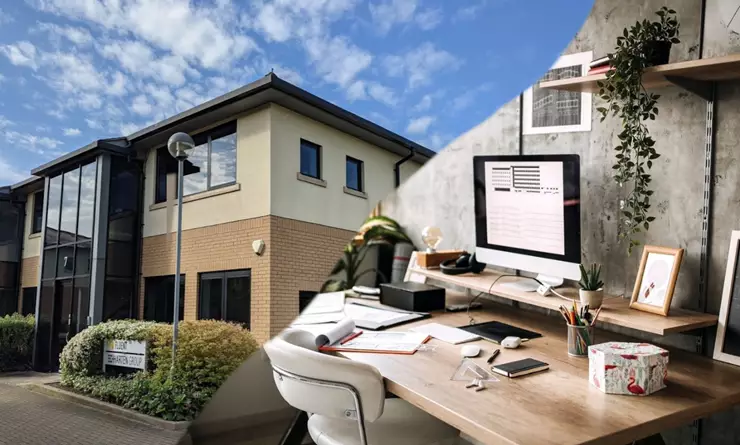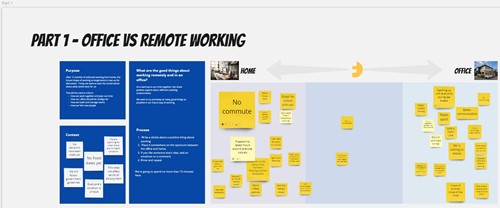Returning to the office - finding our new normal

Following government advice, Fluent has been working from home for 15 months. And although we have a brilliant office space in Histon, there is no precedent for how to return to our once-upon-a-time workplace.
We’re thinking through the next phase together, trying to imagine—or reimagine—what a hybrid home and office work arrangement should look like in a post-lockdown world.
A few weeks ago, we had an all-hands workshop to discuss our personal experiences of remote working. We adapted the structure from an Altassian playbook workshop:

We wanted to get to the crux of the advantages and disadvantages of remote working for each of us and take the opportunity to recognise differing home circumstances, individual roles, personalities, communication styles and needs.
This much was clear: there are tons of positive aspects about working from home, and having greater flexibility with our nine-to-fives is a welcome change (albeit amidst a pandemic). But is it sustainable for our teams, how much have we been relying on our existing social fabric and relationships and how can we develop this in the future? We want to find an approach that gets the best of both worlds - home and office - not a messy compromise that ends up with the worst of both.
Thinking strategically about how to implement this hybrid approach long term is a work in progress. We need to get clear on the most effective, sustainable, and coherent way to do that benefits Fluent as a whole.
Here are some of the things we have discovered so far:
Sorry to interrupt…
If you like what you've read so far, join us on LinkedIn to talk all things digital product development with our team of experts.
Remote working has helped us all structure our time better
Having everyone available online (thanks, Slack), but not physically in view means we’re able to work with fewer interruptions. As such, we’re organising our days and sticking to our plans better.
And while it may be easier to get hold of the right people instantly, online meetings have actually helped us all schedule time in our days more effectively than if we’re dropping by people’s desks.
Which raised this question: how can we retain the benefits of structured time with flexible schedules without creating extra overhead? We’re on the lookout for an effective way to communicate who will be in the office when, to simplify hybrid work scheduling.
People want different things from an office space
We each value coming to the office for a variety of reasons. For some, it’s for collaboration and the opportunity to work with colleagues in person. For others, it’s to find headspace away from home, a separation of taks or a dedicated area to focus.
And sometimes, it’s just plain nice to have social contact, watercooler chats, or the more serendipitous conversations that provide the context and inspiration for our work.
So we’re thinking of using the two floors of our office as a library and a lounge - different physical spaces to be used in different ways.
Mixed-mode meetings are a dilemma
Even a few years BC (Before Covid) we realised that having a meeting where some people are in the office and some are dialling in was pretty unsatisfactory.
Others agree with us, and Atlassian has taken this to its logical limit, saying if one attendee is remote, the whole meeting should be too. But if everyone in the office already has to sit in a separate phone box to join a meeting - it defeats one of the primary purposes of coming in!
Hopefully, mixed-mode meetings can improve with better technology. Microsoft has recognised the problem and has a nice concept to address it - but we don't work in a monochrome dolls house. Perhaps better cameras and mics—like the owl—could make mixed-mode video conferencing more accessible, and I expect there will be many more options coming to market soon as the whole world faces the same problem.
In the meantime, with some conscious effort to run meetings in a way that includes all parties and ensures we behave equally with all participants, I'm hopeful we can work around this.
Hot desks are home for nobody
Home desks are for work, at home, and we have made sure that every Fluenteer has the office equipment they need to work productively and healthily.
We used to have personalised work-stations and dedicated equipment in the office, but this is no longer practical when people are now only in for part of the work of the working week. We need to make desk-sharing effective, even though no-one is truly a fan of hot desking.
The logistics of having the right combination of setup available - monitor cables, power supplies, chair preferences or standing desks - is a question we need to work through.
Do we need to reconsider what we want from our office space?
We have a few years to run on our lease, but it's worth considering the long-term purpose of our office. Is our office a flagship to welcome clients into, a clubhouse for our staff, both or neither?
Historically, our office has been a space for people to come to work, mostly individually, and on their respective desks. But going forward, for many, the home office set-up will provide that role. So it feels like the office’s emphasis will flip the other way, prioritising social and team interaction with some personal space for those who need it.
Our next steps
The plan for the next season is written only in pencil, but here are our ideas:
To meet up more in real life more. A lot of our remote working has leant on the strength of our existing working relationships and we need to invest in these again. This means lots of getting together outside—days out over the summer to get to know our new team members better and catch up on missed opportunities.
To start holding valuable meetings in person. Structuring our time better has meant giving value to different ways of communicating. Ultimately, being together in the same place can inspire creativity, empathy and understanding, which is valuable for the team—so more of it, please!
To find a rhythm that works for individuals and our teams while recognising and being open to the need for change, refining and reshaping over time. We might need to swing the pendulum deliberately back to the office for a while to get ourselves out of our home-working comfort zones, but we want to find the right mixture over the medium term.
To broaden our talent pool. If there is no need to be in the office every day of the week, it becomes feasible to hire people from further away, widening our reach across the region. Whilst being able to cycle to the office is nice, it’s even better when it's not a requirement and we can find more people who are to bring valuable insight, experience, and thinking to our team.
Ready to solve your problems?
We'll help meet the challenges facing your growing business. Get in touch and tell us what you need, the team can't wait to hear from you.


